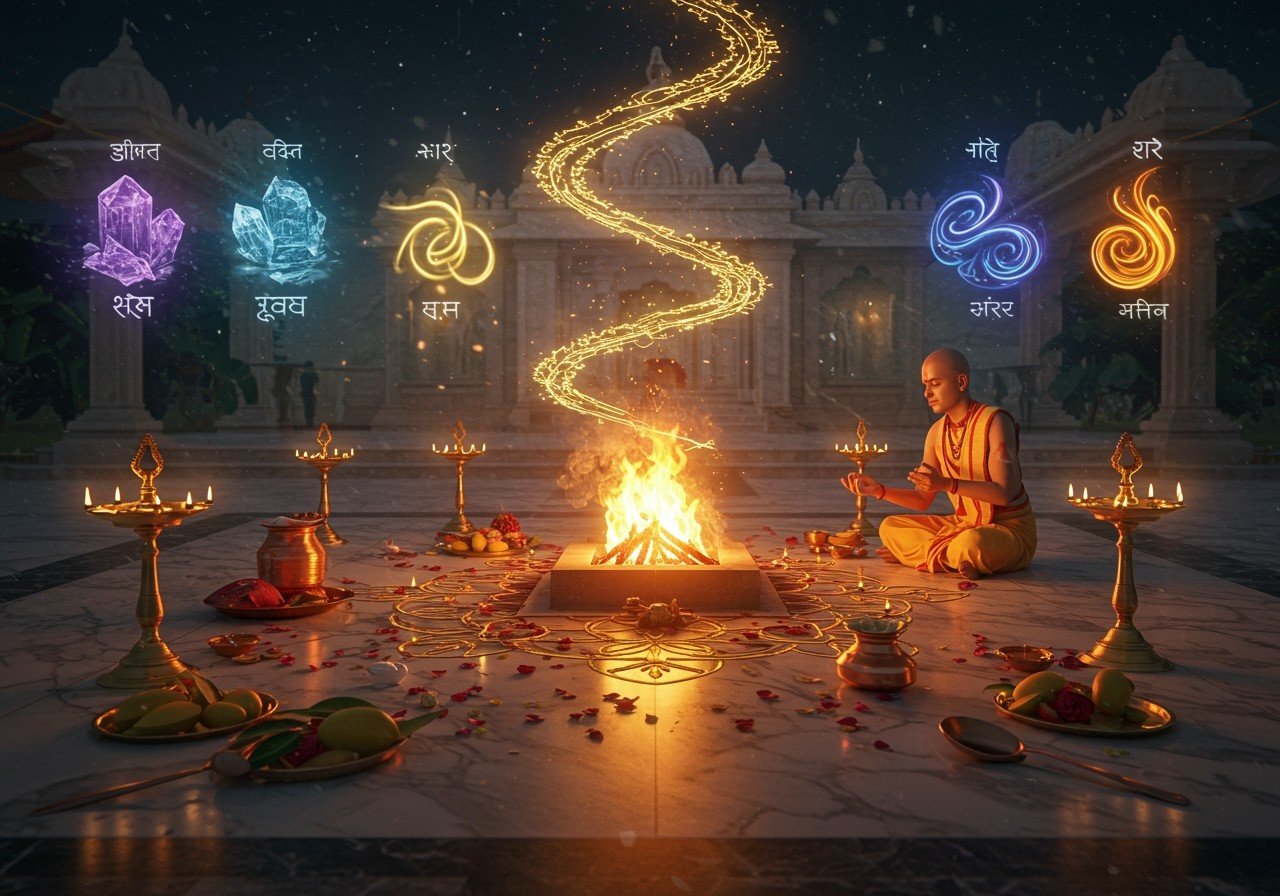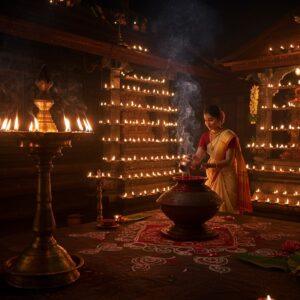
Vedic rituals, deeply embedded in our Indian heritage, are sacred ceremonies originating from the Vedas, the ancient scriptures of Hinduism. These rituals offer a glimpse into the spiritual and philosophical core of ancient Indian society, playing a vital role in upholding cosmic balance and inspiring personal and societal growth. Grasping these practices and utilizing authentic ritual items is essential for performing Vedic ceremonies with reverence and understanding.
Understanding the Essence of Vedic Rituals
The term “Vedic rituals” stems from the Sanskrit word “Veda,” signifying knowledge. These sacred practices are categorized into ‘Shruti’ (that which is heard) and ‘Smriti’ (that which is remembered). The four Vedas—Rigveda, Samaveda, Yajurveda, and Atharvaveda—serve as guiding lights for these rituals. Each Veda holds a unique purpose, enriching the tapestry of Vedic traditions:
- Rigveda: This Veda centers around hymns and praises dedicated to the deities, invoking their blessings and expressing devotion.
- Samaveda: The Samaveda is a collection of melodies and chants, creating a harmonious atmosphere during rituals and uplifting the spirit.
- Yajurveda: This Veda comprises prose mantras employed in rituals, adding depth and sacredness to the ceremonies.
- Atharvaveda: The Atharvaveda encompasses spells and charms for everyday life, offering guidance and protection in various aspects of human existence.
Among these rituals, the Agnihotra stands out, performed daily to honor Agni, the revered fire god. Another significant ritual is the Soma Yajna, involving the offering of the sacred Soma plant, believed to possess divine properties. Priests, known as Brahmins, traditionally conduct these rituals, ensuring they are performed with utmost precision and adherence to sacred guidelines. Understanding Vedic rituals unveils their profound cultural and spiritual significance. They continue to shape contemporary Indian culture by preserving traditions and providing a link to the past.
At poojn.in, we understand the deep significance of these rituals. That’s why we offer a comprehensive selection of Saraswati Puja Dashakarma Kits designed to make your home rituals authentic and convenient. We also carry a wide variety of other Hawan Samagri and Kumkum Roli, ensuring you have everything you need for a sacred and meaningful experience.
Purushamedha: Unraveling the Symbolism
Within the Yajurveda, we encounter the mention of Purushamedha, often interpreted as “human sacrifice.” This ancient text sparks curiosity and, at times, misunderstanding. However, contemporary scholars interpret Purushamedha symbolically rather than literally. The ritual embodies the cosmic Purusha, or universal spirit, highlighting its allegorical essence. The idea of sacrifice in Vedic times has evolved, transitioning from literal interpretations to symbolic acts. This symbolic understanding of Purushamedha strengthens societal structures and promotes cosmic balance. Recognizing this symbolism allows us to appreciate the deeper spiritual meaning embedded within these rituals.
The Significance of Yajna in Vedic Rituals
Yajna, or sacrifice, forms the heart of Vedic rituals. This act establishes a sacred connection between humans and the divine. Various forms of Yajna exist, from animal offerings to plant-based offerings, each bearing unique significance. Dakshina, the offering presented to priests, holds a vital role, ensuring the harmonious cycle of giving and receiving. Through Yajna, individuals sought Svarga (heaven) and Moksha (liberation). These practices played a vital role in maintaining cosmic order and prosperity. However, the concept of sacrifice also gave rise to ethical and philosophical discussions, reflecting the dynamic nature of Vedic traditions.
The Enduring Relevance of Vedic Rituals in Modern Times
In our contemporary world, Vedic rituals continue to adapt while preserving their core essence. There’s a growing resurgence of interest among the Indian diaspora to reconnect with these traditions. Technology and online platforms, like poojn.in, have simplified access to authentic ritual items. Vedic rituals find their place in significant life events, such as weddings, housewarmings, and other important occasions. These rituals offer not only spiritual comfort but also foster a sense of community. The mental well-being nurtured by these practices is invaluable in our fast-paced lives. Balancing tradition and innovation is key. Preserving Vedic traditions becomes even more crucial as we navigate the complexities of modern life. They provide a sense of continuity, cultural identity, and a vital spiritual connection amidst constant change. Explore the world of Vedic ceremonies further by reading our insightful blogs on Ganesh Puja and Hindu Rituals. These resources offer a deeper understanding of the practices and their significance.
Poojn.in: Your Companion in Vedic Rituals
Poojn.in simplifies the performance of Vedic rituals by offering all the necessary puja items in one convenient location. As India’s leading Dashakarma bhandar, we provide:
- Comprehensive puja samagri kits tailored for specific rituals and ceremonies.
- Individual puja items, including dhoop, agarbatti, and ghee.
- Pure copper and brass ritual items crafted with traditional expertise.
- Authentic Vedic ritual guides and instructions to assist you every step of the way.
- Expert guidance on ritual requirements, ensuring your ceremonies are performed with authenticity.
You can have everything you need for Vedic rituals delivered right to your doorstep. Our products are carefully chosen to adhere to traditional standards and specifications. For personalized assistance with ritual items:
- Call us: 03369029784
- WhatsApp: 9476142738
- Visit: www.poojn.in
Embracing the Timeless Wisdom of Vedic Rituals
As we conclude our exploration of Vedic rituals, we are enriched by the wisdom they offer. These age-old practices, deeply rooted in our heritage, continue to illuminate our lives today. They are more than mere rituals; they are a bridge connecting the past and the present, linking us to our ancestors and their profound understanding of the universe. By embracing the symbolic meanings embedded within these rituals, we uncover a treasure trove of spiritual insights, guiding us towards harmony within ourselves and with the world around us. Engaging with Vedic traditions fosters a sense of continuity and belonging, keeping our cultural identity vibrant and alive. In our rapidly changing world, the timeless wisdom of Vedic rituals provides stability and grounding. By preserving their essence while allowing for modern adaptations, we ensure these sacred practices remain relevant and cherished for generations to come. As we honor these traditions, we celebrate the rich tapestry of our heritage, allowing it to thrive and inspire us in our daily lives.
FAQs: Unveiling the Mysteries of Vedic Rituals
What is the Purushamedha mentioned in the Vedas? Purushamedha, often translated as “human sacrifice,” is a Vedic ritual referenced in ancient texts like the Yajurveda. Though the term suggests a literal sacrifice, it is widely interpreted symbolically, representing the offering of one’s self to the divine and the interconnectedness of humanity with the cosmos.
Are Vedic rituals still practiced today? Yes, Vedic rituals continue to be practiced in contemporary times, adapting to modern contexts. They are often performed during significant life events like weddings, naming ceremonies, and festivals, keeping the traditions alive and relevant.
How do Vedic rituals connect to Indian culture? Vedic rituals are deeply interwoven with Indian culture, forming the bedrock of numerous cultural practices and traditions. They influence aspects of life from daily routines to grand ceremonies, nurturing a sense of spirituality and community.
Why are Vedic rituals important? Vedic rituals offer a pathway to connect with the divine and foster harmony in life. They provide structure and meaning, creating a sense of tradition and continuity across generations.


